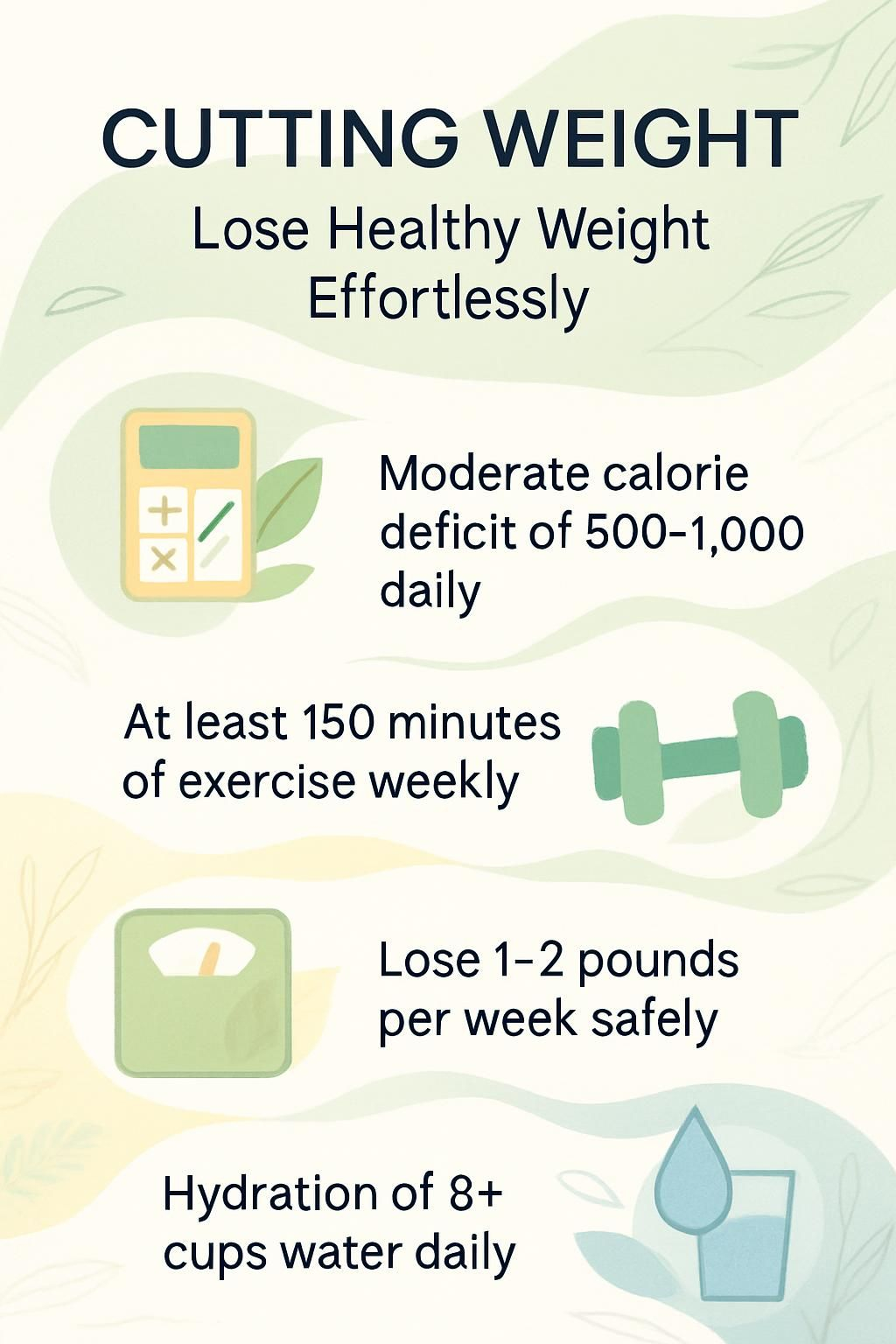Cutting Weight: Lose Healthy Weight Effortlessly
Our Nutrition Assistant AI Suite will transform your body. You will lose fat, get toned, and build muscle. Gain confidence and optimal health.
You want to lose weight, yet cutting weight can feel messy and unclear. According to the Mayo Clinic, steady changes in healthy eating and regular exercise work best for long-term results. This guide gives you simple steps to cut calories, build strong habits, and track progress without guesswork. Small moves stack up, and they can help you lose healthy weight safely.
Key Takeaways
- A safe weight cut pairs a modest calorie deficit, about 500 to 1,000 calories per day, with at least 150 minutes of weekly activity for steady fat loss (CDC).
- Most experts, including the Mayo Clinic, suggest losing 1 to 2 pounds per week, focusing on whole foods, enough protein, and simple tracking with journals or apps.
- Weight plateaus happen. Adjust calories by 100 to 200 per day, add strength work, and avoid risky tactics like diuretics or laxatives.
- High protein intake, about 1.1 to 1.4 grams per pound of body weight, daily hydration of at least 8 cups, and 7 to 9 hours of sleep support muscle during a cut.
- Crash plans and fad diets often backfire. Over 80% of people regain lost weight within a year after rapid fixes, according to the National Institutes of Health.

What Is Weight Cutting and Why Is It Beneficial?

Weight cutting means trimming body fat to reach a target weight for health or sport. Many people use tips on cutting weight to improve body composition, lower disease risk, and support type 2 diabetes care. Think of it as a planned season of eating and activity that aims at fat loss while keeping strength.
What does weight cutting mean?
Cutting weight is a short-term phase where you lower body weight on purpose. You create a calorie deficit, which means eating fewer calories than your body uses each day. This can be done for health goals or to make a sport weight class, like boxing or wrestling.
Two styles show up often. The first is gradual fat loss over weeks. The second is rapid water loss in the final days before an event, which is common in combat sports. Dieting is the safer method for athletes such as Adam Piccolotti who prepare for training camps and tournaments.
I used a strict but healthy diet with fewer calories per meal leading up to my last fight, says professional athlete Adam Piccolotti. Tracking every snack and drink helped me lose 10 pounds without feeling weak.
What are the benefits of safe weight cutting?
Safe cutting helps you lose weight without wrecking energy or muscle. A moderate deficit of 500 to 1,000 calories a day supports long-term fat loss and reduces muscle loss. The CDC suggests aiming for 1 to 2 pounds per week.
This approach can help you maintain muscle mass while lowering body fat, which matters if you lift weights. It also lowers risk for cardiovascular disease and type 2 diabetes as excess adipose tissue shrinks. Eating vegetables, fruit, lean protein, whole grains, and healthy fats makes it easier to skip added sugar and sweetened beverages.
I once tried crash diets that promised big results. I felt hungry and drained. Shifting to gradual changes, like cooking more whole foods, helped me feel full on fewer calories and make steady progress.
Steps for Healthy Weight Loss
You can build healthy habits with clear goals and simple tracking. A balanced diet and regular physical activity may help you lose weight safely and keep it off.
How do I identify my motivation for weight loss?
Start with your why. Internal reasons tend to last longer than outside pressure. Write a short list. Common reasons include better heart health, lower risk of type 2 diabetes, or feeling ready to play with your child without getting winded.
Place quick reminders where you will see them, like a note on the fridge or near your walking shoes. Ask yourself if you are ready to change habits, even on busy days. People who lose weight and keep it off often say their personal reasons pulled them through hard weeks.
How can I track my current habits effectively?
Use a journal or an app to log meals, snacks, drinks, exercise, and sleep. Writing down every cereal bowl or soft drink reveals patterns that slow weight loss.
Track meal times, portion sizes, and triggers like stress or boredom. Practice mindful eating, which means paying attention to taste and fullness with fewer screens at the table. A registered dietitian can help you spot gaps and set targets you can maintain.
How do I set achievable and specific weight loss goals?
Set both action goals and outcome goals. An action goal is what you do, such as Walk 30 minutes every morning. An outcome goal is the result, such as Lose 10 pounds or Drop 5% of current body weight. The American Heart Association suggests starting with about 9 pounds if you weigh around 180 pounds.
Aim for about 0.5 to 1% of your body weight per week. This steady pace protects muscle and lets your appetite adjust. When I followed this plan last year, tracking small wins kept me going after setbacks. If you stall, revisit your plan with a healthcare professional or a sports nutrition expert.
How can I find and build a support system?
Tell supportive friends or family about your goals. Ask for help planning meals or walking together. Join a local or online group where people share progress and ideas.
If stress feels heavy, consider meeting with a health professional. Guidance reduces guesswork and helps you stay on track. Decide how much support you need. Everyone faces different hurdles, especially if losing 20 pounds or more.
How often should I monitor my progress?
Check progress at least weekly. Use the same scale, same day, and similar conditions, like morning before breakfast. The Mayo Clinic supports regular check-ins with trusted tools, including apps.
Measure waist size monthly to see fat loss even if the scale is slow due to muscle gain from training. Share your records with a healthcare professional if you want help adjusting your plan.
Key Components of a Cutting Diet
A cutting diet trims calories while guarding muscle. Focus on nutrient-dense foods so you can stay full, meet vitamin needs, and keep training.
How do I calculate a calorie deficit for weight loss?
First, estimate maintenance calories with a reliable online calculator. Enter your age, sex, height, weight, and activity level. That number is what keeps your weight stable.
Subtract about 500 calories a day to target roughly 1 pound, 0.45 kilogram, of loss per week. Many people track food with an app to stay accurate. Very large deficits can increase muscle loss and fatigue, so keep changes modest. If you are unsure, work with a healthcare professional.
What is the right balance of protein, fat, and carbs?
Set protein first. Aim for 1.1 to 1.4 grams per pound of body weight. Fat can be 20 to 30% of total calories. Fill the rest with carbohydrates to support training and recovery.
| Macro | Target Range | Calories per gram | Example Notes |
|---|---|---|---|
| Protein | 1.1-1.4 g per lb body weight | 4 | 155 lb person, about 170-215 g |
| Fat | 20-30% of daily calories | 9 | At 2,000 kcal, about 44-67 g |
| Carbs | Remainder of calories | 4 | Varies based on protein and fat choices |
Spread protein across meals and snacks. Eggs at breakfast, yogurt at lunch, or a shake after training all help. During my last cut, this pattern kept me full and kept workouts strong.
Why focus on whole, nutrient-dense foods?
Whole foods pack vitamins, minerals, and fiber for fewer calories. Choose vegetables, fruit, beans, lentils, and whole grains like brown rice and whole-wheat bread. Include lean proteins and healthy fats from olive oil, nuts, and seeds.
Set a simple target: at least 4 servings of vegetables and 3 servings of fruit daily. Processed items often add sugar and oil, which makes it easy to overshoot calories. Low-fat or fat-free dairy gives protein and calcium with fewer saturated fats.
How important are meal timing and portion control?
Meal timing matters less than total intake. A 2019 study found that a higher calorie breakfast may reduce hunger later, yet total calories still decide weight change. Portion control is the lever you can pull every day.
Use smaller plates, serve yourself once, and pause before a second helping. Practice mindful eating. Turn off screens, taste your food, and stop when you feel satisfied, not stuffed.
Healthy Lifestyle Tips to Support Weight Loss
Healthy habits make your cut easier to maintain. Think water, sleep, stress control, and fiber, the foundation that supports every meal and workout.
How much water should I drink daily?
Hydration helps control appetite and supports performance. Aim for at least 8 cups, about 2 liters, of water each day. If you train hard or live in hot weather, you may need 10 to 12 cups.
Staying hydrated can ease fatigue and reduce muscle cramps. When I tracked my intake, sipping water before meals cut snacking later. Carry a bottle and set phone reminders so hydration becomes automatic.
Why is sleep important for weight loss and hormone regulation?
Sleep tunes hunger hormones. Short sleep raises ghrelin, which increases hunger, and lowers leptin, which signals fullness. That shift often leads to overeating.
Adults who sleep fewer than 7 hours have a higher risk of weight gain. Target 7 to 9 hours most nights. Good sleep also supports insulin function and keeps stress hormones in check.
What are effective ways to manage stress?
Use quick tools that lower cortisol, the stress hormone. Try deep breathing, a 10-minute walk, or a short mindfulness session. Regular exercise also lifts mood and calms tension, according to the American Psychological Association.
Plan for triggers before your cut begins. Journaling, talking with a friend, or meeting a counselor can prevent stress eating. I learned that a short walk after work kept me from raiding the pantry.
How does fiber support gut health during weight loss?
Fiber keeps digestion regular and helps you feel full on fewer calories. Focus on whole grains, beans, vegetables, and fruit. Aim for at least 25 grams per day.
Higher fiber intake supports beneficial gut bacteria and lowers constipation risk. I swapped chips for apples and oatmeal. After a week, digestion improved and cravings fell.
Effective Exercise Strategies
Exercise boosts fat loss and protects muscle during a cut. Mix cardio and resistance work, then use smart recovery to stay consistent.
How does cardio help with burning calories?
Cardio, like brisk walking, cycling, or swimming, raises your heart rate and burns calories. A 30-minute session most days helps create your deficit. The CDC recommends at least 150 minutes of moderate cardio each week.
Cardio can also lift mood and improve blood pressure. During a month of daily jogs, I saw steady fat loss without extreme diets. Pick a style you enjoy so you can stick with it.
Why is strength training important for preserving muscle?
Strength training tells your body to keep muscle while you cut calories. Lift weights or use bodyweight moves at least two days per week. Pair this with a reasonable calorie deficit so you lose fat, not strength.
Research shows people who lift while dieting keep more lean mass than those who only diet or only do cardio. Skipping resistance work increases the chance of muscle loss and a slower metabolism.
What are the benefits of high-intensity interval training (HIIT)?
High-intensity interval training alternates short bursts of effort with brief rests. Studies show HIIT can burn more calories in less time than steady cardio. Twenty minutes of intervals may rival forty-five minutes of jogging.
Your metabolism stays elevated after a HIIT session, which adds bonus calorie burn. Many people enjoy the variety. You also gain heart-health benefits and improved insulin sensitivity faster.
How do flexibility and recovery impact weight loss?
Stretching and recovery days help your body handle training. Flexibility work, such as yoga or simple stretches, improves range of motion and lowers injury risk.
Recovery includes sleep, light movement, and rest days. Good recovery lets muscles repair and grow. Extra daily movement counts too. Take stairs, stand during calls, and walk during TV breaks. These small choices add calories burned without extra stress.
Common Challenges and How to Overcome Them
Cutting weight rarely moves in a straight line. Expect stalls and busy weeks, then use clear fixes to keep momentum.
How can I break through weight loss plateaus?
Make small, focused changes. Lower or raise calories by 100 to 200 per day to test response. Add a strength session or try a short HIIT workout twice a week. Track meals closely, even condiments and oils.
Increase non-exercise steps. Park farther away or take a five-minute walk each hour. Plateaus are normal as your metabolism adapts. Consistency is the main tool that moves the scale again.
Why should I avoid fad diets and quick fixes?
Fad diets promise speed, then cause rebound. NIH reports show more than 80% regain lost weight within a year after extreme plans. Many crash diets cut entire food groups or slash calories too low.
Risks include low energy, nutrient gaps, and yo-yo dieting. Choose balanced meals, regular activity, and mindful eating. A dietitian or healthcare professional can help you plan a safe path.
How do I recognize and manage hunger cues?
Learn your body’s signals. True hunger grows slowly and may include stomach growling or low energy. Thirst or boredom can feel similar.
Eat more slowly. Pause halfway through the meal to check fullness. Avoid phones and TV during meals so you can notice cues. I used a 1 to 10 hunger scale and aimed to stop at 6 or 7. It made portions easier to manage.
How can I stay consistent with weight loss during busy times?
Plan twice, cook once. Batch-cook proteins and vegetables, then mix and match during the week. Keep simple snacks, like fruit, nuts, or yogurt, close at hand. A two-hour prep day can save many rushed decisions later.
Track the basics with a simple app. Focus on small daily actions rather than perfection. Steady habits beat perfect weeks that you cannot repeat.
Advanced Weight Cutting Tips
Once the basics feel smooth, fine-tune your plan. These methods can help you personalize your cut and protect your progress.
How does intermittent fasting support weight loss?
Intermittent fasting limits eating to certain hours or days. Many people find it reduces snacking and total calories. A 2017 study in endurance athletes suggests meal timing may aid recovery and shift hormones toward fat use.
Your hunger may drop after a few days as your routine settles. I used an eight-hour eating window with balanced meals and lost five pounds in six weeks without strict counting.
What are cheat meals and refeed days, and how to use them?
Cheat meals let you enjoy a favorite food, then return to your plan at the next meal. Refeed days are different. You raise carbs for one or two days each week while protein and fat stay steady. Research from 2021 suggests refeed days may lift leptin and slightly increase energy burn for a short time.
Most post-cheat weight is water and fades within days. Set limits for both strategies. Plan portions in advance and keep your next meal nutrient-dense to avoid a spiral.
How should I adjust calories gradually over time?
Start a cut with roughly a 500-calorie daily deficit. Track meals so you can adjust based on progress. In weeks seven and eight, add back 50 to 100 calories every few days until you reach maintenance. This helps protect muscle and prevents fast regain.
Some people prefer a short fasting window during transitions. Choose the method that keeps training strong and hunger reasonable.
Why avoid extreme methods like diuretics or laxatives?
Diuretics and laxatives cause water loss, not fat loss. They raise the risk of cramps, irregular heartbeat, kidney problems, and serious salt imbalances. These risks climb in hot conditions and during hard training.
In December 2015, MMA fighter Yang Jian Bing died from dehydration while cutting weight. I tried laxative teas once before a race. I felt weak for days and performed poorly. Safe nutrition and patient progress protect your health and your results.
FAQs About Weight Cutting
Here are clear answers to common questions so you can move forward with confidence. Use them to choose the plan that fits your goals and timeline.
How long does a typical cutting phase last?
Most cutting phases last 2 to 4 months. This window allows steady fat loss while you maintain muscle with weightlifting. Extending much longer can raise the risk of diet fatigue and muscle loss. Very short cuts may not allow enough time for measurable change.
Should I bulk first or start cutting?
Let your goal choose the path. If you want more muscle, bulk first, then cut. Many athletes build in winter and cut before competition or summer. If lower body fat is your top priority, start with a cut that emphasizes a calorie deficit and high protein.
Pick one focus to make tracking simple. Rapid switches can weaken results, according to guidance from the American College of Sports Medicine.
What are the risks of losing weight too quickly?
Large deficits can strip muscle along with fat and slow metabolism. Dehydration tactics are even riskier. Quick drops raise the chance of fatigue, dizziness, and heart problems.
During one wrestling season, I skipped meals and water. The headaches and cramps were constant. Slow, steady loss keeps you safer and makes results easier to maintain.
Maintaining Results After Weight Loss
Maintenance is a skill. Keep the core habits that got you here, then build a simple system to catch small regains early.
How do I transition to maintenance calorie levels?
After reaching goal weight, increase intake by 100 to 200 calories per week. Use a tracking app or the Mayo Clinic Diet Online tool. Adjust portions slowly as activity changes, then watch the trend.
Weigh in weekly. If your weight holds steady for 2 to 4 weeks, you are likely near maintenance. I added calories gradually with small snacks. Energy improved and my weight stayed stable.
What healthy habits should I continue long-term?
Keep a balanced plate with vegetables, fruit, lean protein, and fiber-rich grains. The National Weight Control Registry reports that many people who keep weight off eat breakfast daily.
Stay active with at least 150 minutes a week of exercise and lift weights regularly. Drink 8 to 10 cups of water, depending on activity. Sleep 7 to 9 hours to keep hunger hormones steady. Manage stress with simple routines like breathing exercises or short walks. Ongoing self-monitoring helps prevent slow regain.
How can I track progress to prevent weight regain?
Use a log or app to track food, workouts, steps, weight, and waist size. Brief weekly reviews help you spot trends. Studies suggest that people who log meals are more likely to maintain weight loss.
Set small targets, such as a weekly weigh-in and a daily step goal. Celebrate non-scale wins like better sleep or stronger workouts. If numbers climb, tighten portions for a week and return to your baseline routine.
Conclusion
Healthy weight cutting works best with clear goals, a modest calorie deficit, and steady habits. Focus on whole foods, protein, water, sleep, and regular exercise. These steps help you lose weight and keep it off. If you have a medical condition, or if anything feels off, talk with a healthcare professional. Safe changes today can lead to lasting success.
Information in this article is for education only and does not replace medical advice. Sources: Mayo Clinic, Centers for Disease Control and Prevention, American College of Sports Medicine, International Society of Sports Nutrition, National Institutes of Health.
FAQs
1. What is the healthiest way to cut weight without risking muscle loss?
The best method for healthy weight reduction combines a balanced diet with regular physical activity. Focus on eating lean proteins, whole grains, fruits, and vegetables while reducing processed foods and sugary drinks. Studies show that combining resistance training with moderate calorie restriction helps preserve muscle tissue during fat loss.
2. How many pounds per week can I lose safely when cutting weight?
Experts recommend losing one to two pounds each week for lasting results. Research from the Centers for Disease Control and Prevention supports this rate as safe and sustainable over time.
3. Does tracking calories help in effortless weight management?
Tracking food intake increases awareness of eating habits; it often leads to better choices and improved portion control. A 2020 study found that people who tracked their meals lost more body mass than those who did not record their intake.
4. Can you share a personal experience about making healthy changes while cutting weight?
After switching from soda to water and walking daily after dinner, I noticed steady progress within weeks; my energy increased, cravings dropped, and my clothes fit better by month’s end.
Summary: Healthy weight reduction relies on gradual progress through nutritious food choices, consistent exercise routines, mindful monitoring of intake, and practical lifestyle adjustments supported by scientific evidence or real-life application.







